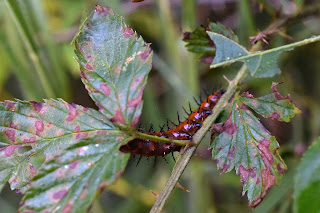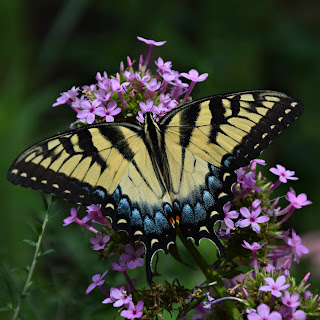 |
| Even the adults benefit from the 'weeds' |
August is one of the peak caterpillar months around here. Last year I had a lot of fun exploring the yard for caterpillars and I found a lot while I was looking. When I’m not looking, I rarely notice any (except the fall webworms, of course).
I’m guessing that most people don’t notice them either. Unfortunately, not noticing them means that many get destroyed in “clean up” efforts.
This chrysalis belongs to a future Gulf Fritillary butterfly. For two weeks, it sits in this drab twist, hidden among the weeds near where it munched a wild vine as a caterpillar.
This one is in a neighbor’s yard. I showed it to her when I asked her for cuttings from her passionflower vine (Passiflora incarnata) to feed my growing caterpillars. She didn’t know that the vine was there; it was twining among the weeds where her vegetable garden used to be. It grew strong and vigorous among thorny blackberries and dogfennel (Eupatorium capillifolium).
 |
| Gulf fritillary caterpillar on blackberry near host plant |
By the time I showed it to her, it had flowered numerous times, set fruit (“What are these, limes?” she said), and nurtured several caterpillars into butterflies.
Any day now, when he’s not busy, her husband will probably notice the tangle and tackle it with pruners – turning the whole butterfly factory into a heap of dead branches.
Any day now, when he’s not busy, her husband will probably notice the tangle and tackle it with pruners – turning the whole butterfly factory into a heap of dead branches.
 |
| Carolina satyrs making more in my yard |
Down the street, the wild roadside sprouts more butterfly factories: more passionvine, partridge pea (Chamaecrista fasciculata) for sulphur butterflies, butterfly pea (Clitoria mariana) for silver-spotted skippers, false foxglove (Agalinis tenuifolia) for buckeye butterflies, and numerous grasses for a number of small butterflies like the Carolina satyr and some skippers.
A few days ago, one of the roadsides was aggressively mowed – what caterpillars and chrysalides were in that stretch?
 |
| Cloudless sulphur on partridge pea leaf |




















